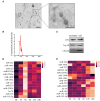The Regulation of Staphylococcus aureus-Induced Inflammatory Responses in Bovine Mammary Epithelial Cells
- PMID: 34136558
- PMCID: PMC8200483
- DOI: 10.3389/fvets.2021.683886
The Regulation of Staphylococcus aureus-Induced Inflammatory Responses in Bovine Mammary Epithelial Cells
Abstract
Mastitis, an inflammatory disease, causes severe economic loss in the dairy industry, which is mainly infected by bacteria. Staphylococcus aureus (S. aureus), the major pathogenic microorganism, derived from lipoteichoic acid (LTA) has been identified to activate inflammatory responses, but the cellular or intercellular regulatory mechanism is unclear. This study mainly focused on the effects of LTA in bovine mammary epithelial cells (Mac-T) and elaborated the regulation of microRNAs (miRNAs). The results showed that LTA enhanced the messenger RNA (mRNA) expression and production of tumor necrosis factor α (TNF-α) and interleukin (IL)-6. Furthermore, LTA could activate Toll-like receptor (TLR)2/MyD88-mediated phosphoinositide 3-kinase (PI3K)/AKT pathway, and TLR2 plays a pivotal role in LTA-induced inflammatory responses. The results of qRT-PCR showed that miRNA levels increased and reached the highest at 3 h and then gradually decreased over time in Mac-T cells. In exosomes, the levels of 11 and three miRNAs were upregulated and downregulated at 24 h, respectively. In addition, miR-23a showed the highest increase in Mac-T cells treated with LTA and targeted PI3K to regulate inflammatory responses. Furthermore, Mac-T cell-derived exosomes were identified to play a cell-cell communication by promoting M1 polarization of bovine macrophages. In summary, our study demonstrated that LTA could activate inflammatory responses via TLR2/MyD88/PI3K/AKT signaling pathway, and miR-23a inhibited it by targeting PI3K. Furthermore, we found that Mac-T cell-derived exosomes might be associated with inflammatory responses by promoting M1 polarization of bovine macrophages.
Keywords: LTA; exosome; mammary epithelial cells; mastitis; miR-23a.
Copyright © 2021 Cai, Fan, Li, Sun, Dai, Lei, Dai and Liao.
Conflict of interest statement
The authors declare that the research was conducted in the absence of any commercial or financial relationships that could be construed as a potential conflict of interest.
Figures






Similar articles
-
Mammary epithelial cell derived exosomal MiR-221 mediates M1 macrophage polarization via SOCS1/STATs to promote inflammatory response.Int Immunopharmacol. 2020 Jun;83:106493. doi: 10.1016/j.intimp.2020.106493. Epub 2020 Apr 11. Int Immunopharmacol. 2020. PMID: 32289739
-
Gene expression profiling of bovine mammary gland epithelial cells stimulated with lipoteichoic acid plus peptidoglycan from Staphylococcus aureus.Int Immunopharmacol. 2014 Jul;21(1):231-40. doi: 10.1016/j.intimp.2014.05.002. Epub 2014 May 14. Int Immunopharmacol. 2014. PMID: 24836680
-
Bta-miR-223 Targeting CBLB Contributes to Resistance to Staphylococcus aureus Mastitis Through the PI3K/AKT/NF-κB Pathway.Front Vet Sci. 2020 Aug 21;7:529. doi: 10.3389/fvets.2020.00529. eCollection 2020. Front Vet Sci. 2020. PMID: 33195489 Free PMC article.
-
Sodium Phenylbutyrate Ameliorates Inflammatory Response Induced by Staphylococcus aureus Lipoteichoic Acid via Suppressing TLR2/NF-κB/NLRP3 Pathways in MAC-T Cells.Molecules. 2018 Nov 22;23(12):3056. doi: 10.3390/molecules23123056. Molecules. 2018. PMID: 30469547 Free PMC article.
-
MCPIP1 mediates inflammatory responses induced by lipopolysaccharide and lipoteichoic acid in bovine mammary epithelial cells.Acta Biochim Biophys Sin (Shanghai). 2019 Feb 1;51(2):150-158. doi: 10.1093/abbs/gmy163. Acta Biochim Biophys Sin (Shanghai). 2019. PMID: 30590418
Cited by
-
Effect of Two Different Drug-Resistant Staphylococcus aureus Strains on the Physiological Properties of MAC-T Cells and Their Transcriptome Analysis.Front Vet Sci. 2022 Jun 24;9:818928. doi: 10.3389/fvets.2022.818928. eCollection 2022. Front Vet Sci. 2022. PMID: 35812882 Free PMC article.
-
Extracellular vesicle miRNome during subclinical mastitis in dairy cows.Vet Res. 2024 Sep 19;55(1):112. doi: 10.1186/s13567-024-01367-x. Vet Res. 2024. PMID: 39300590 Free PMC article.
-
Exosomes in Mastitis-Research Status, Opportunities, and Challenges.Animals (Basel). 2022 Oct 21;12(20):2881. doi: 10.3390/ani12202881. Animals (Basel). 2022. PMID: 36290266 Free PMC article. Review.
-
Prolactin regulates H3K9ac and H3K9me2 epigenetic marks and miRNAs expression in bovine mammary epithelial cells challenged with Staphylococcus aureus.Front Microbiol. 2022 Sep 23;13:990478. doi: 10.3389/fmicb.2022.990478. eCollection 2022. Front Microbiol. 2022. PMID: 36212825 Free PMC article.
-
Immune defenses of the mammary gland epithelium of dairy ruminants.Front Immunol. 2022 Oct 21;13:1031785. doi: 10.3389/fimmu.2022.1031785. eCollection 2022. Front Immunol. 2022. PMID: 36341445 Free PMC article. Review.
References
-
- Valckenier D, Piepers S, De Visscher A, Bruckmaier RM, De Vliegher S. Effect of intramammary infection with non-aureus staphylococci in early lactation in dairy heifers on quarter somatic cell count and quarter milk yield during the first 4 months of lactation. J Dairy Sci. (2019) 102:6442–53. 10.3168/jds.2018-15913 - DOI - PubMed
LinkOut - more resources
Full Text Sources

